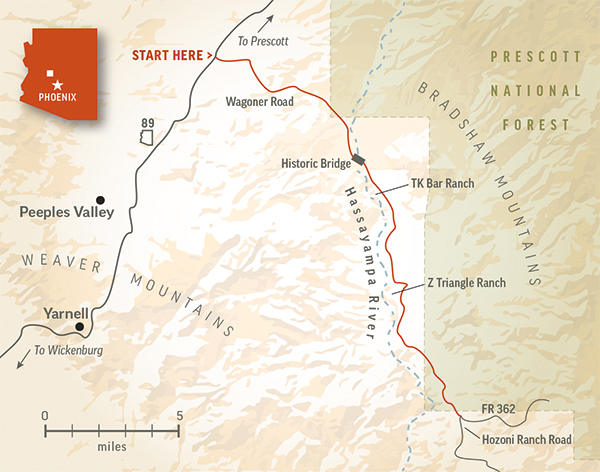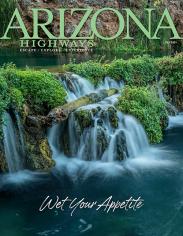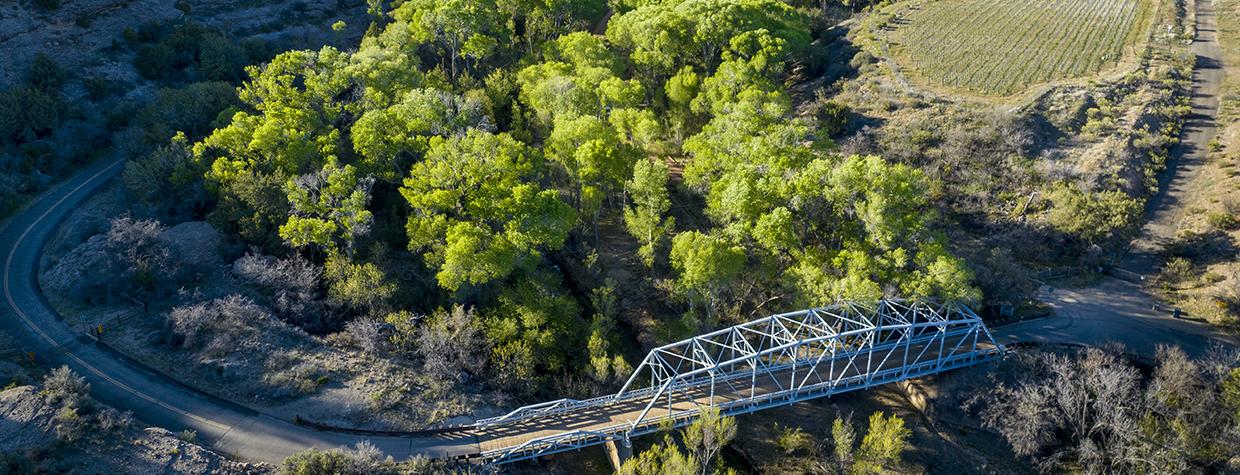In the desert, life happens where the water is. In the mountains of Central Arizona, that reality is on full display — and not just when it comes to flora and fauna. Since the 1800s, the availability of water here has dictated where humans could settle, mine for precious minerals, and raise cattle and crops. An easy drive on Wagoner Road offers a scenic look at one important water source, the Hassayampa River — and some glimpses of history along the way.
Wagoner Road begins on State Route 89 northeast of the Weaver Mountains communities of Yarnell and Peeples Valley. From there, head southeast on a road that starts out unpaved but quickly transitions to smooth blacktop. You’ll roll through a desert scrub landscape, with a few junipers mixed in, as the route traverses a series of gentle hills. At Mile 3.3, you’ll curve to the left, around a jumble of boulders painted with the brands of several area ranches. You’ll get familiar with some of those properties later on.
Soon thereafter, you’ll crest a hill and get a panoramic view of the Bradshaw Mountains to the east. You’ll then begin a descent toward the Hassayampa, which is marked by a vibrant ribbon of cottonwoods and other trees snaking through the desert. You’ll see other greenery, including junipers and piñon pines, en route to a historic bridge over the river at Mile 8.4.
As a nearby plaque explains, this bridge, which features a wooden bed, was completed in 1924 in response to area residents’ pleas for a permanent wagon bridge over the river. Today, it’s listed on the National Register of Historic Places, and what you’ll see is essentially how it looked in the 1920s, plus a little rust. What you might not see is water running under the bridge — like many Arizona waterways, the Hassayampa mostly flows underground, except during periods of heavy rainfall.
Past the bridge, you’ll pass through the TK Bar Ranch, once a dude ranch and now a working cattle outfit; according to some sources, the stonework visible along the road was created by masons brought in from Italy in the mid-1900s. The pavement on Wagoner Road ends shortly after you exit the ranch, and the road — now a smooth, wide dirt path — climbs back into a mesquite-dominated desert landscape.
Much of the rest of the drive continues to parallel the Hassayampa, and you’ll get several more glimpses of cottonwoods on the right. After you pass through another ranch, the Z Triangle, around Mile 15, you’ll navigate a few ups and downs and enjoy an up-close look at these tall trees, which are commonly found along desert water sources in Arizona.
This area played a role in one of the state’s most tragic chapters. In 1890, the poorly designed Walnut Grove Dam, located southwest of present-day Wagoner Road, collapsed and sent 4 billion gallons of the Hassayampa’s water rushing downstream, killing as many as 100 people. The ill-fated dam was part of a plan to use river water for hydraulic mining — another example of this precious resource shaping Arizona’s human history.
The drive ends after 22.3 miles, at an intersection with Hozoni Ranch Road. From here, Wagoner Road gets much rougher and steeper as it winds into the Bradshaws, so enjoy the view, then retrace your path back to SR 89 for a different perspective on water in the desert.
ADDITIONAL READING: For more adventure, pick up a copy of our book Arizona Highways Scenic Drives, which features 40 of the state's most beautiful back roads. To order, visit www.shoparizonahighways.com/100scenicdrives.

Tour Guide
Note: Mileages are approximate.
Length: 22.3 miles one way (from State Route 89)
Directions: From State Route 89 about 12 miles northeast of Yarnell, go southeast on Wagoner Road for 22.3 miles to Hozoni Ranch Road.
Vehicle Requirements: A high-clearance vehicle, such as an SUV or truck, is recommended for the second half of the drive, which is unpaved. The route crosses several washes, so do not attempt the drive after recent heavy rain or if rain is in the forecast.
Warning: Back-road travel can be hazardous, so be aware of weather and road conditions. Carry plenty of water. Don’t travel alone, and let someone know where you are going and when you plan to return.
Travelers in Arizona can visit www.az511.gov or dial 511 to get information on road closures, construction, delays, weather and more.

